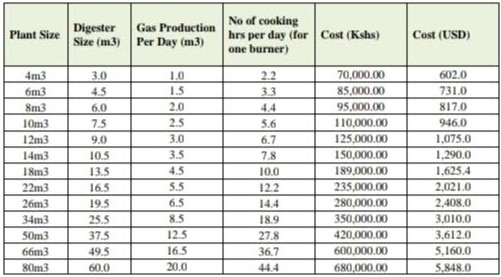Authors: Anthony M. Wanjohi1 and Hosea Ciuti Gicheru2
1,2 Kenya Projects Organization
P.O. Box 15509-00503, Mbagathi, Nairobi-Kenya
Corresponding Author Email: wanjohi@kenpro.org
Abstract: The purpose of this article is to provide a review of the cost implication of installing a Fixed Dome Biogas Plant in Kenya. The first part highlights the introduction of biogas in Kenya; the second part covers the cost effectiveness and before drawing a conclusion.
Introduction
Biogas as a renewable source of energy was introduced in Kenya in the 1950s by Tim
Hutchinson. He used coffee pulp as the primary raw material that generated alternative energy for the home farm (Wanjohi, Irungu & Gicheru, 2022). Since the introduction of biogas plants in the Kenya, many more designs that are more cost and size effective have been developed. The benefits and importance of biogas use continues to grow as well as the availability of raw materials has grown the demand for biogas plants (Wanjohi, 2022).
Biogas has been taughted as one of the ways that will help the world tackle the issue of climate change; create a viable long term solution in the issue of renewable energy. It is therefore imperative for us to evaluate the importance and benefits that are associated with application of biogas as a solution to climate change.
Biogas technology in Kenya have been on a steady incline as it provides a cheaper alternative source of energy to LPG, firewood and charcoal. The technology has been of great affluence in society; being used for various applications including cooking, lighting, heating among many other benefits. These projects have gathered a large support base owing to their influence to the locals (Day, Chen, Anderson & Steinberg, 1990).
Despite the many benefits that are associated with biogas technology, there are a couple of challenges. One challenge that stands out the most is the cost implication of the installation of biogas digester (Sara, 2017). This article provides an overview of the cost implication of installating biogas plant in Kenya’s context .
Cost Effectiveness
The cost of installation of a biogas plant may seem to be a costly venture at first, however, the long term benefit of undertaking the project is considerably better than using non-renewable energy. The benefits of installing biogas surely outweigh the cost of installing the plant. Table 1 shows cost estimate of installing a biogas plant in Kenya.
Table 1. Cost estimate of installing a biogas plant in Kenya
As shown in Table 1, the cost estimate of a biogas plant is mainly anchored on size. However, there are other parameters that could influence the cost including construction materials and the nature of the ground ( because of digging the pit in case of fixed biogas plant).
Conclusion
The cost of installing a biogas plant despite the cost seeming to be high, the long term cost benefit cannot be ignored. The savings on the cost of gas, lighting, heating and fertilizer over the years is negligible to the cost incurred for the installation. It is hereby a consideration that should be highly accepted in the community.
References
Njagi, K. (2016). Biogas heats up in Kenya as fuel of choice for the poor
Sara, T. (2017). Fact Sheet Biogas: Converting Waste to Energy.
Wanjohi, A. M., Irungu, E. K., & Gicheru, H. C. (2022). Biogas program in Kenya: History, Challenges and Milestones. International Journal of Environmental and Health Sciences (JEHS), 2, 1-3.
Wanjohi, A.M. (2022). The Blue Flame: Biogas Training Blueprint. Nairobi: Kenya Projects Organization
For inquiries about the installation of Biogas Plant for Domestic and Commercial use at household and institutional levels, kindly contact KENPRO Support Team or call us +254725788400.

